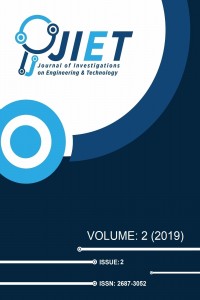The Effect of Calcination Conditions on Luminescence Efficiency of BeO Ceramics Synthesized Using Co-Precipitation Method
Öz
BeO ceramics were
synthesized by co-precipitation method. The luminescent behaviors of the BeO
ceramics prepared under different reaction conditions were investigated for
radiation dosimetry applications. The appropriate calcination temperature and
time for the sol-gel synthesis of BeO was determined as 1000 °C for 4 hours by
analyzing optically stimulated luminescence (OSL), thermoluminescence (TL)
sensitivities and radioluminescence (RL) emissions of the products. While
similar characteristic broad emission peak of BeO ceramics between 200 and 500
nm was obtained in RL spectra, an unexpected peak between 650 and 800 nm which
may be associated with the anion defects in BeO was observed. While highly
sensitive two TL peaks were observed up to 250 °C, low sensitive four TL peaks
were found up to 650 °C. The results showed that luminescent signals from the
BeO pellets produced at appropriate synthesis conditions were suitable for
radiation measurement applications in personal dosimetry.
Anahtar Kelimeler
Beryllium oxide (BeO) Precipitation synthesis Calcination Conditions Radiation Dosimetry Luminescence
Destekleyen Kurum
Çukurova Üniversitesi
Proje Numarası
FDK-2018-10190
Teşekkür
This project has been supported by the Çukurova University Rectorate through the project FDK-2018-10190. We are grateful to Çukurova University Rectorate for their supports. We appreciate Prof. Kasım Kurt for RL measurements.
Kaynakça
- [1] Rivera, T. (2011). Synthesis and thermoluminescent characterization of ceramics materials. Advances in ceramics–synthesis and characterization, processing and specific applications. InTech, Rijeka, Croatia, 127-164.
- [2] Boch, P., & Niepce, J.-C. (2010). Ceramic Materials: Processes, Properties, and Applications (Vol. 98): John Wiley & Sons.
- [3] Carter, C. B., & Norton, M. G. (2007). Ceramic materials: science and engineering (Vol. 716): Springer.
- [4] Albrecht, H. O., & Mandeville, C. E. (1956). Storage of Energy in Beryllium Oxide. Physical Review, 101(4), 1250-1252. doi:10.1103/PhysRev.101.1250
- [5] Rhyner, C. R., & Miller, W. G. (1970). Radiation dosimetry by optically-stimulated luminescence of BeO. Health Physics, 18, 681-684.
- [6] Tochilin, E., Goldstein, N., & Miller, W. (1969). Beryllium oxide as a thermoluminescent dosimeter. Health Physics, 16(1), 1-7.
- [7] McKeever, S. W., Moscovitch, M., & Townsend, P. D. (1995). Thermoluminescence dosimetry materials: properties and uses.
- [8] Bulur, E., & Goksu, H. Y. (1998). OSL from BEO ceramics: New observations from an old material. Radiation Measurements, 29(6), 639-650. doi:Doi 10.1016/S1350-4487(98)00084-5
- [9] Bos, A. J. J. (2001). High sensitivity thermoluminescence dosimetry. Nuclear Instruments & Methods in Physics Research Section B-Beam Interactions with Materials and Atoms, 184(1-2), 3-28. doi:Doi 10.1016/S0168-583x(01)00717-0
- [10] Sommer, M., & Henniger, J. (2006). Investigation of a BeO-based optically stimulated luminescence dosemeter. Radiat Prot Dosimetry, 119(1-4), 394-397. doi:10.1093/rpd/nci626
- [11] Sommer, M., Jahn, A., & Henniger, J. (2008). Beryllium oxide as optically stimulated luminescence dosimeter. Radiation Measurements, 43(2-6), 353-356. doi:10.1016/j.radmeas.2007.11.018
- [12] Jahn, A., Sommer, M., Ullrich, W., Wickert, M., & Henniger, J. (2013). The BeOmax system – Dosimetry using OSL of BeO for several applications. Radiation Measurements, 56, 324-327. doi:10.1016/j.radmeas.2013.01.069
- [13] Altunal, V., Guckan, V., Ozdemir, A., Sotelo, A., & Yegingil, Z. (2019). Effect of sintering temperature on dosimetric properties of BeO ceramic pellets synthesized using precipitation method. Nuclear Instruments and Methods in Physics Research Section B: Beam Interactions with Materials and Atoms, 441, 46-55.
- [14] Altunal, V., Guckan, V., Ozdemir, A., Can, N., & Yegingil, Z. (2019). Luminescence characteristics of Al-and Ca-doped BeO obtained via a sol-gel method. Journal of Physics and Chemistry of Solids.doi: https://doi.org/10.1016/j.jpcs.2019.04.003
Öz
Proje Numarası
FDK-2018-10190
Kaynakça
- [1] Rivera, T. (2011). Synthesis and thermoluminescent characterization of ceramics materials. Advances in ceramics–synthesis and characterization, processing and specific applications. InTech, Rijeka, Croatia, 127-164.
- [2] Boch, P., & Niepce, J.-C. (2010). Ceramic Materials: Processes, Properties, and Applications (Vol. 98): John Wiley & Sons.
- [3] Carter, C. B., & Norton, M. G. (2007). Ceramic materials: science and engineering (Vol. 716): Springer.
- [4] Albrecht, H. O., & Mandeville, C. E. (1956). Storage of Energy in Beryllium Oxide. Physical Review, 101(4), 1250-1252. doi:10.1103/PhysRev.101.1250
- [5] Rhyner, C. R., & Miller, W. G. (1970). Radiation dosimetry by optically-stimulated luminescence of BeO. Health Physics, 18, 681-684.
- [6] Tochilin, E., Goldstein, N., & Miller, W. (1969). Beryllium oxide as a thermoluminescent dosimeter. Health Physics, 16(1), 1-7.
- [7] McKeever, S. W., Moscovitch, M., & Townsend, P. D. (1995). Thermoluminescence dosimetry materials: properties and uses.
- [8] Bulur, E., & Goksu, H. Y. (1998). OSL from BEO ceramics: New observations from an old material. Radiation Measurements, 29(6), 639-650. doi:Doi 10.1016/S1350-4487(98)00084-5
- [9] Bos, A. J. J. (2001). High sensitivity thermoluminescence dosimetry. Nuclear Instruments & Methods in Physics Research Section B-Beam Interactions with Materials and Atoms, 184(1-2), 3-28. doi:Doi 10.1016/S0168-583x(01)00717-0
- [10] Sommer, M., & Henniger, J. (2006). Investigation of a BeO-based optically stimulated luminescence dosemeter. Radiat Prot Dosimetry, 119(1-4), 394-397. doi:10.1093/rpd/nci626
- [11] Sommer, M., Jahn, A., & Henniger, J. (2008). Beryllium oxide as optically stimulated luminescence dosimeter. Radiation Measurements, 43(2-6), 353-356. doi:10.1016/j.radmeas.2007.11.018
- [12] Jahn, A., Sommer, M., Ullrich, W., Wickert, M., & Henniger, J. (2013). The BeOmax system – Dosimetry using OSL of BeO for several applications. Radiation Measurements, 56, 324-327. doi:10.1016/j.radmeas.2013.01.069
- [13] Altunal, V., Guckan, V., Ozdemir, A., Sotelo, A., & Yegingil, Z. (2019). Effect of sintering temperature on dosimetric properties of BeO ceramic pellets synthesized using precipitation method. Nuclear Instruments and Methods in Physics Research Section B: Beam Interactions with Materials and Atoms, 441, 46-55.
- [14] Altunal, V., Guckan, V., Ozdemir, A., Can, N., & Yegingil, Z. (2019). Luminescence characteristics of Al-and Ca-doped BeO obtained via a sol-gel method. Journal of Physics and Chemistry of Solids.doi: https://doi.org/10.1016/j.jpcs.2019.04.003
Ayrıntılar
| Birincil Dil | İngilizce |
|---|---|
| Bölüm | Araştırma Makaleleri |
| Yazarlar | |
| Proje Numarası | FDK-2018-10190 |
| Yayımlanma Tarihi | 26 Aralık 2019 |
| Gönderilme Tarihi | 23 Ekim 2019 |
| Kabul Tarihi | 25 Aralık 2019 |
| Yayımlandığı Sayı | Yıl 2019 Cilt: 2 Sayı: 2 |


